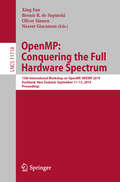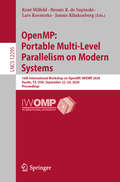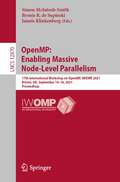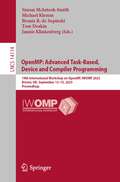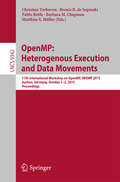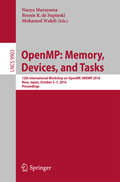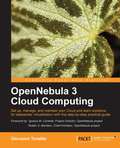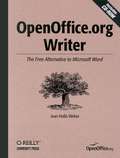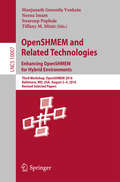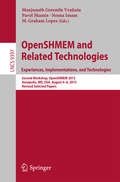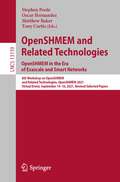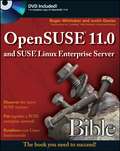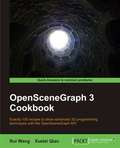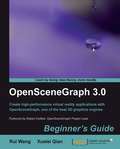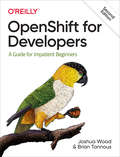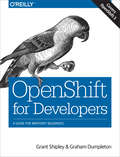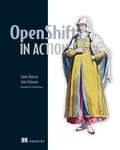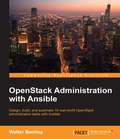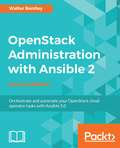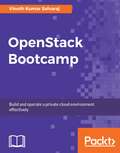- Table View
- List View
OpenMP: 15th International Workshop on OpenMP, IWOMP 2019, Auckland, New Zealand, September 11–13, 2019, Proceedings (Lecture Notes in Computer Science #11718)
by Bronis R. de Supinski Xing Fan Oliver Sinnen Nasser GiacamanThis book constitutes the proceedings of the 15th International Workshop on Open MP, IWOMP 2019, held in Auckland, New Zealand, in September 2019. The 22 full papers presented in this volume were carefully reviewed and selected for inclusion in this book. The papers are organized in topical sections named: best paper; tools, accelerators, compilation, extensions, tasking, and using OpenMP.
OpenMP: 16th International Workshop on OpenMP, IWOMP 2020, Austin, TX, USA, September 22–24, 2020, Proceedings (Lecture Notes in Computer Science #12295)
by Bronis R. de Supinski Kent Milfeld Lars Koesterke Jannis KlinkenbergThis book constitutes the proceedings of the 16th International Workshop on OpenMP, IWOMP 2020, held in Austin, TX, USA, in September 2020. The conference was held virtually due to the COVID-19 pandemic. The 21 full papers presented in this volume were carefully reviewed and selected for inclusion in this book. The papers are organized in topical sections named: performance methodologies; applications; OpenMP extensions; performance studies; tools; NUMA; compilation techniques; heterogeneous computing; and memory.The chapters ‘A Case Study on Addressing Complex Load Imbalance in OpenMP’ and ‘A Study of Memory Anomalies in OpenMP Applications’ are available open access under a Creative Commons Attribution 4.0 License via link.springer.com.
OpenMP: 17th International Workshop on OpenMP, IWOMP 2021, Bristol, UK, September 14–16, 2021, Proceedings (Lecture Notes in Computer Science #12870)
by Bronis R. de Supinski Jannis Klinkenberg Simon McIntosh-SmithThis book constitutes the proceedings of the 17th International Workshop on OpenMP, IWOMP 2021, held virtually in September 2021 and hosted by the High Performance Computing research group at the University of Bristol, UK.The 15 full papers presented in this volume were carefully reviewed and selected for inclusion in this book. The papers are organized in topical sections named: synchronization and data; tasking expansions; applications; case studies; and heterogenous computing and memory. Chapter ‘FOTV: A Generic Device Offloading Framework for OpenMP’ is available open access under a Creative Commons Attribution 4.0 International License via link.springer.com.
OpenMP: 19th International Workshop on OpenMP, IWOMP 2023, Bristol, UK, September 13–15, 2023, Proceedings (Lecture Notes in Computer Science #14114)
by Bronis R. de Supinski Michael Klemm Jannis Klinkenberg Simon McIntosh-Smith Tom DeakinThis book constitutes the proceedings of the 19th International Workshop on OpenMP, IWOMP 2023, held in Bristol, UK, during September 13–15, 2023.The 15 full papers presented in this book were carefully reviewed and selected from 20 submissions. The papers are divided into the following topical sections: OpenMP and AI; Tasking Extensions; OpenMP Offload Experiences; Beyond Explicit GPU Support; and OpenMP Infrastructure and Evaluation.
OpenMP: Heterogenous Execution and Data Movements
by Christian Terboven Bronis R. de Supinski Pablo Reble Barbara M. Chapman Matthias S. MüllerThis book constitutes the refereed proceedings of the 11th International Workshop on OpenMP, held in Aachen, Germany, in October 2015. The 19 technical full papers presented were carefully reviewed and selected from 22 submissions. The papers are organized in topical sections on applications, accelerator applications, tools, extensions, compiler and runtime, and energy.
OpenMP: Memory, Devices, and Tasks
by Naoya Maruyama Bronis R. Supinski Mohamed WahibThis book constitutes the proceedings of the 12th International Workshop on OpenMP, IWOMP 2016, held in Nara, Japan, in October 2016. The 24 full papers presented in this volume were carefully reviewed and selected from 28 submissions. They were organized in topical sections named: applications, locality, task parallelism, extensions, tools, accelerator programming, and performance evaluations and optimization.
OpenNI Cookbook
by Soroush FalahatiThis is a Cookbook with plenty of practical recipes enriched with explained code and relevant screenshots to ease your learning curve. If you are a beginner or a professional in NIUI and want to write serious applications or games, then this book is for you. Even OpenNI 1 and OpenNI 1.x programmers who want to move to new versions of OpenNI can use this book as a starting point. This book uses C++ as the primary language but there are some examples in C# and Java too, so you need to have about a basic working knowledge of C or C++ for most cases.
OpenNebula 3 Cloud Computing
by Giovanni ToraldoThis is a step-by-step practical guide to get you started easily with openNebula. It guides you to build, maintain, and configure your cloud infrastructure, providing real-world examples in a simple and coherent manner. If you are a GNU/Linux system administrator with no experience with virtualization or cloud computing but eager to learn about it, or you are thwarted by your current virtualized infrastructure, this book is for you. You are expected to have some basic knowledge of GNU/Linux, with knowledge of basic package management tools and system configuration.
OpenOffice.org Writer
by Jean Hollis WeberThanks to OpenOffice.org, there is an alternative to Microsoft Word. If you've ever been frustrated by Word's quirks and limitations--including its price tag--and longed for a practical alternative, then it's time to break free. OpenOffice.org is the free, open source office suite and its word processor, Writer, has proven extremely popular with both Windows and Linux users. How good can it be if it's free? you might ask. And how much trouble will it be to install and learn? A quick tour of the program will show you: the features you use regularly--from formatting and spell check to using templates and creating indexes --are all there. And Writer's intuitive, surprisingly familiar interface lets you navigate with ease. To quickly master the ins and outs of Writer, you'll want a copy of OpenOffice.org Writer: The Free Alternative to Microsoft Word . This handy reference is packed with essential information to help you learn the basics of Writer and become adept with its advanced features. Written for intermediate and advanced users of word processing programs, OpenOffice.org Writer: The Free Alternative to Microsoft Word provides guidance for common and advanced word processing tasks. With this book, you'll learn how to: Set up OOoWriter to work your way Write, edit, and review documents Control page layout Use templates and styles effectively Get the most from using fields Work with Tables of contents, indexes, bibliographies Manage large or complex documents Insert, edit and create graphics Make a smooth transition from Microsoft Word OpenOffice.org Writer: The Free Alternative to Microsoft Word provides guidance for anyone who wants to break out of the Word rut. Its detailed Table of Contents make it a handy reference for even the most experienced word processing users who want to get up to speed quickly with this program, or make sure they're taking full advantage of OOo Writer's features. With the complete office suite included on a CD (which you can install on as many machines as you like), this book makes using Writer an easy decision. OpenOffice.org Writer: The Free Alternative to Microsoft Word is part of the O'Reilly Community Press Series. Unlike classic O'Reilly animal books, O'Reilly's role in the series is limited to providing manufacturing and distribution services rather than editorial development, so that each Community Press title reflects the editorial voice and organization of the community that has created it.
OpenSHMEM and Related Technologies. Enhancing OpenSHMEM for Hybrid Environments
by Manjunath Gorentla Venkata Neena Imam Swaroop Pophale Tiffany M. MintzThis book constitutes the proceedings of the Third OpenSHMEM Workshop, held in Baltimore, MD, USA, in August 2016. The 14 full papers and 3 short papers presented were carefully reviewed and selected from 25 submissions. The papers discuss a variety of ideas of extending the OpenSHMEM specification and making it efficient for current and next generation systems. This included active messages, non-blocking APIs, fault tolerance capabitlities, exploring implementation of OpenSHMEM using communication layers such as OFI and UCX and implementing OpenSHMEM for heterogeneous architectures.
OpenSHMEM and Related Technologies. Experiences, Implementations, and Technologies
by Manjunath Gorentla Venkata Pavel Shamis Neena Imam M. Graham LopezThis book constitutes the proceedings of the SecondOpenSHMEM Workshop, held in Annapolis, MD, USA, in August 2015. The 12 technical papers and one short position paperspresented in this book were carefully reviewed and selected from 17submissions. The topics of the workshop included extensions to the OpenSHMEMAPI, implementation of the API for current and emerging architectures, tools todebug and profile OpenSHMEM programs, experience porting applications to theOpenSHMEM programming model, and changes to the OpenSHMEM specification toaddress the needs of programming exascale systems.
OpenSHMEM and Related Technologies. OpenSHMEM in the Era of Exascale and Smart Networks: 8th Workshop on OpenSHMEM and Related Technologies, OpenSHMEM 2021, Virtual Event, September 14–16, 2021, Revised Selected Papers (Lecture Notes in Computer Science #13159)
by Tony Curtis Matthew Baker Stephen Poole Oscar HernandezThis book constitutes the proceedings of the 8th OpenSHMEM Workshop, held in virtually in August 2021. The 11 full papers and 1 short paper presented in this book were carefully reviewed and selected for inclusion in this volume from 18 submissions. The papers are organized in the following topical sections: Applications and Implementations, Tools and Benchmarks, and Applications and Implementations.
OpenSHMEM and Related Technologies. OpenSHMEM in the Era of Extreme Heterogeneity: 5th Workshop, Openshmem 2018, Baltimore, Md, Usa, August 21-23, 2018, Revised Selected Papers (Lecture Notes in Computer Science #11283)
by Manjunath Gorentla Venkata Neena Imam Swaroop Pophale Ferrol AderholdtThis book constitutes the proceedings of the 5th OpenSHMEM Workshop, held in Baltimore, MD, USA, in August 2018. <P><P> The 14 full papers presented in this book were carefully reviewed and selected for inclusion in this volume. The papers discuss a variety of ideas for extending the OpenSHMEM specification and discuss a variety of concepts, including interesting use of OpenSHMEM in HOOVER – a distributed, flexible, and scalable streaming graph processor and scaling OpenSHMEM to handle massively parallel processor arrays. The papers are organized in the following topical sections: OpenSHMEM library extensions and implementations; OpenSHMEM use and applications; and OpenSHMEM simulators, tools, and benchmarks.
OpenSUSE 11.0 and SUSE Linux Enterprise Server Bible
by Justin Davies Roger WhittakerPresenting updated coverage of openSUSE 11. 0 and SUSE Linux Enterprise Server 11. 0, this reference is written by Novell insiders and boasts the most up-to-date information available Topics covered include the openSUSE project, command line programs and implementing online services, virtualization, kernel updates, Enterprise Architecture, and more Reviews Linux fundamentals such as methodologies, partitions, and file system, and features a new section devoted entirely to end-user needs The DVD includes the openSUSE 11. 0
OpenSceneGraph 3 Cookbook
by Xuelei Qian Rui WangThis is a cookbook full of recipes with practical examples enriched with code and the required screenshots for easy and quick comprehension. You should be familiar with the basic concepts of the OpenSceneGraph API and should be able to write simple programs. Some OpenGL and math knowledge will help a lot, too.
OpenSceneGraph 3.0: Beginner's Guide
by Xuelei Qian Rui WangWritten with a fast-paced but friendly and engaging approach, this Packt Beginner's Guide is designed to be placed alongside the computer as your guide and mentor. Step-by-step tutorials are bolstered by explanations of the reasoning behind what you are doing. You will quickly pick up the necessary skills, tips, and tricks for creating successful 3D graphics with practical examples that help you to learn by experiment and play.This book is intended for software developers who are new to OpenSceneGraph and considering using it in their applications. It is assumed that you have basic knowledge of C++ before using this book, especially the standard template library (STL) constructs, of which OSG makes extensive use. Some familiarity with design patterns as implemented in C++ is also useful, but is not required.You need to be familiar with OpenGL, the standard cross-platform low-level 3D graphics API. We'll meet some maths in the book--geometry and linear algebra--and familiarity with these topics will be great, but you don't need to be a maths whiz to use this book.
OpenShift Cookbook
by Shekhar GulatiIf you are a web application developer who wants to use the OpenShift platform to host your next big idea but are looking for guidance on how to achieve this, then this book is the first step you need to take. This is a very accessible cookbook where no previous knowledge of OpenShift is needed.
OpenShift Multi-Cluster Management Handbook: Go from architecture to pipelines using GitOps
by Giovanni Fontana Rafael Pecora Marcos AmorimDiscover best practices for designing and scaling robust OpenShift clusters' architecture for different workloadsManage multiple clusters on-premise or in the cloud using multi-cluster management tools to keep them secure and compliantImplement multi-cluster CI/CD on OpenShift using GitOpsKey FeaturesDiscover best practices to design robust OpenShift architecture and scale them to different workloadsUnderstand the minimal collection of topics you should consider in your container security strategyImplement multi-cluster CI/CD on OpenShift using GitOpsBook DescriptionFor IT professionals working with Red Hat OpenShift Container Platform, the key to maximizing efficiency is understanding the powerful and resilient options to maintain the software development platform with minimal effort. OpenShift Multi-Cluster Management Handbook is a deep dive into the technology, containing knowledge essential for anyone who wants to work with OpenShift.This book starts by covering the architectural concepts and definitions necessary for deploying OpenShift clusters. It then takes you through designing Red Hat OpenShift for hybrid and multi-cloud infrastructure, showing you different approaches for multiple environments (from on-premises to cloud providers). As you advance, you'll learn container security strategies to protect pipelines, data, and infrastructure on each layer. You'll also discover tips for critical decision making once you understand the importance of designing a comprehensive project considering all aspects of an architecture that will allow the solution to scale as your application requires.By the end of this OpenShift book, you'll know how to design a comprehensive Red Hat OpenShift cluster architecture, deploy it, and effectively manage your enterprise-grade clusters and other critical components using tools in OpenShift Plus.What you will learnUnderstand the important aspects of OpenShift cluster architectureDesign your infrastructure to run across hybrid cloudsDefine the best strategy for multitenancy on OpenShiftDiscover efficient troubleshooting strategies with OpenShiftBuild and deploy your applications using OpenShift Pipelines (Tekton)Work with ArgoCD to deploy your applications using GitOps practicesMonitor your clusters' security using Red Hat Advanced Cluster SecurityWho this book is forThis book is for a wide range of IT professionals using or looking to use OpenShift with a hybrid/multi-cloud approach. In this book, IT architects will find practical guidance on OpenShift clusters' architecture, while Sysadmins, SREs, and IT operators will learn more about OpenShift deployment, troubleshooting, networking, security, and tools to manage multiple clusters from a single pane. For DevOps engineers, this book covers CI/CD strategies for multiple clusters using GitOps. Equipped with just basic knowledge of containerization and Kubernetes, you're ready to get started.
OpenShift for Developers: A Guide for Impatient Beginners
by Joshua Wood Brian TannousReady to build cloud native applications? Get a hands-on introduction to daily life as a developer crafting code on OpenShift, the open source container application platform from Red Hat. Creating and packaging your apps for deployment on modern distributed systems can be daunting. Too often, adding infrastructure value can complicate development. With this practical guide, you'll learn how to build, deploy, and manage a multitiered application on OpenShift.Authors Joshua Wood and Brian Tannous demonstrate how OpenShift speeds application development. With the Kubernetes container orchestrator at its core, OpenShift simplifies and automates the way you build, ship, and run code. You'll learn how to use OpenShift and the Quarkus Java framework to develop and deploy apps using proven enterprise technologies and practices that you can apply to code in any language.Learn the development cycles for building and deploying on OpenShift, and the tools that drive themUse OpenShift to build, deploy, and manage the ongoing lifecycle of an n-tier applicationCreate a continuous integration and deployment pipeline to turn your source code changes into production rolloutsAutomate scaling decisions with metrics and trigger lifecycle events with webhooks
OpenShift for Developers: A Guide for Impatient Beginners
by Grant Shipley Graham DumpletonKeen to build web applications for the cloud? Get a quick hands-on introduction to OpenShift, the open source Platform as a Service (PaaS) offering from Red Hat. With this practical guide, you’ll learn the steps necessary to build, deploy, and host a complete real-world application on OpenShift without having to slog through long, detailed explanations of the technologies involved. OpenShift enables you to use Docker application containers and the Kubernetes cluster manager to automate the way you create, ship, and run applications. Through the course of the book, you’ll learn how to use OpenShift and the Wildfly application server to build and then immediately deploy a Java application online. Learn about OpenShift’s core technology, including Docker-based containers and Kubernetes; Use a virtual machine with OpenShift installed and configured on your local environment; Create and deploy your first application on the OpenShift platform; Add language runtime dependencies and connect to a database; Trigger an automatic rebuild and redeployment when you push changes to the repository; Get a working environment up in minutes with application templates; Use commands to check and debug your application; Create and build Docker-based images for your application.
OpenShift in Action
by John Osborne Jamie DuncanSummaryOpenShift in Action is a full reference to Red Hat OpenShift that breaks down this robust container platform so you can use it day-to-day. Combining Docker and Kubernetes, OpenShift is a powerful platform for cluster management, scaling, and upgrading your enterprise apps. It doesn't matter why you use OpenShift—by the end of this book you'll be able to handle every aspect of it, inside and out! Foreword by Jim Whitehurst, Red Hat. Purchase of the print book includes a free eBook in PDF, Kindle, and ePub formats from Manning Publications.About the TechnologyContainers let you package everything into one neat place, and with Red Hat OpenShift you can build, deploy, and run those packages all in one place! Combining Docker and Kubernetes, OpenShift is a powerful platform for cluster management, scaling, and upgrading your enterprise apps.About the BookOpenShift in Action is a full reference to Red Hat OpenShift that breaks down this robust container platform so you can use it day-to-day. Starting with how to deploy and run your first application, you'll go deep into OpenShift. You'll discover crystal-clear explanations of namespaces, cgroups, and SELinux, learn to prepare a cluster, and even tackle advanced details like software-defined networks and security, with real-world examples you can take to your own work. It doesn't matter why you use OpenShift—by the end of this book you'll be able to handle every aspect of it, inside and out! What's InsideWritten by lead OpenShift architectsRock-solid fundamentals of Docker and KubernetesKeep mission-critical applications up and runningManage persistent storageAbout the ReaderFor DevOps engineers and administrators working in a Linux-based distributed environment.About the AuthorsJamie Duncan is a cloud solutions architect for Red Hat, focusing on large-scale OpenShift deployments. John Osborne is a principal OpenShift architect for Red Hat.Table of ContentsPART 1 - FUNDAMENTALSGetting to know OpenShift Getting started Containers are Linux PART 2 - CLOUD-NATIVE APPLICATIONSWorking with services Autoscaling with metrics Continuous integration and continuous deployment PART 3 - STATEFUL APPLICATIONS Creating and managing persistent storage Stateful applications PART 4 - OPERATIONS AND SECURITYAuthentication and resource access Networking Security
OpenSolaris Bible
by Nicholas A. SolterAfter a beginning overview of the history of OpenSolaris, its open-source licensing, and the community development model, this book then goes on to highlight the aspects of OpenSolaris that differ from more familiar operating systems. You'll learn how to become a power user of OpenSolaris by maximizing the abilities of advanced features like Dtrace, the fault management architecture, ZFS, the service management facility, and Zones. Authors provide insider tips, unique tricks, and practical examples to help you stay sharp with the latest features of OpenSolaris.
OpenStack Administration with Ansible
by Walter BentleyDesign, build, and automate 10 real-world OpenStack administrative tasks with Ansible About This Book * Automate real-world OpenStack cloud operator administrative tasks * Construct a collection of automation code to save time on managing your OpenStack cloud * Use this step-by-step tutorial to automate such tasks with Ansible Who This Book Is For If you are an OpenStack-based cloud operator and/or infrastructure administrator and are interested in automating administrative functions, then this book is exactly what you are looking for. Having a functioning OpenStack environment is helpful, but most certainly not necessary. What You Will Learn * Efficiently execute OpenStack administrative tasks * Familiarize yourself with how Ansible works and assess the defined best practices * Create Ansible playbooks and roles * Automate tasks to customize your OpenStack cloud * Review OpenStack automation considerations when automating administrative tasks * Examine and automate advanced OpenStack tasks and designated use cases * Get a high-level overview of OpenStack and the current production-ready projects * Deep dive into OpenStack CLI tools and find out how to use them In Detail Most organizations are seeking methods to improve business agility because they have realized just having a cloud is not enough. Being able to improve application deployments, reduce infrastructure downtime, and eliminate daily manual tasks can only be accomplished through some sort of automation. Packed with real-world OpenStack administrative tasks, this book will walk you through working examples and explain how these tasks can be automated using one of the most popular open source automation tools--Ansible. We will start with a brief overview of OpenStack and Ansible and highlight some best practices. Each chapter will provide an introduction to handling various Cloud Operator administration tasks such as creating multiple users/tenants, setting up Multi-Tenant Isolation, customizing your clouds quotas, taking instance snapshots, evacuating compute hosts for maintenance, and running cloud health checks, and a step-by-step tutorial on how to automate these tasks with Ansible. Style and approach This easy-to-follow reference guide is packed with examples of real-world OpenStack administration tasks; each task is explained in detail and then subsequently turned into automation code.
OpenStack Administration with Ansible 2 - Second Edition
by Walter BentleyOrchestrate and automate your OpenStack cloud operator tasks with Ansible 2.0 About This Book • Automate real-world OpenStack cloud operator administrative tasks • Construct a collection of the latest automation code to save time on managing your OpenStack cloud • Manage containers on your cloud and check the health of your cloud using Nagios Who This Book Is For This book is aimed at OpenStack-based cloud operators and infrastructure and sys administrators who have some knowledge of OpenStack and are seeking to automate taxing and manual tasks. This book is also for people new to automating cloud operations in general and the DevOps practice in particular. What You Will Learn • Efficiently execute OpenStack administrative tasks • Familiarize yourself with how Ansible 2 works and assess the defined best practices • Create Ansible 2 playbooks and roles • Automate tasks to customize your OpenStack cloud • Review OpenStack automation considerations when automating administrative tasks • Examine and automate advanced OpenStack tasks and designated use cases • Get a high-level overview of OpenStack and current production-ready projects • Explore OpenStack CLI tools and learn how to use them In Detail Most organizations are seeking methods to improve business agility because they have realized just having a cloud is not enough. Being able to improve application deployments, reduce infrastructure downtime, and eliminate daily manual tasks can only be accomplished through some sort of automation. We start with a brief overview of OpenStack and Ansible 2 and highlight some best practices. Each chapter will provide an introduction to handling various Cloud Operator administration tasks such as managing containers within your cloud; setting up/utilizing open source packages for monitoring; creating multiple users/tenants; taking instance snapshots; and customizing your cloud to run multiple active regions. Each chapter will also supply a step-by-step tutorial on how to automate these tasks with Ansible 2. Packed with real-world OpenStack administrative tasks, this book will walk you through working examples and explain how these tasks can be automated using one of the most popular open source automation tools on the market today. Style and approach This book is a concise, fast-paced guide filled with real-world scenarios that will execute OpenStack administrative tasks efficiently. It serves as a quick reference guide for not just OpenStack functions, but also for creating future Ansible code.
OpenStack Bootcamp
by Vinoth Kumar SelvarajA focused and systematic introduction to OpenStack, the largest open source cloud platform, using practical examples and hands-on problems. About This Book • Explore all the new features of OpenStack's Mikata, Ocata, and Newton releases and get up to speed with OpenStack in no time • Learn something new each day to successfully build a private cloud platform • A fast-paced guide filled with best practices that will help you manage your virtual private cloud efficiently Who This Book Is For This book is for those who are already familiar with OpenStack's supporting technologies. It's ideal for cloud system engineers, system administrators, and technical architects who are moving from a virtualized environment to a cloud environment. Prior knowledge of cloud computing platforms and virtualization would be beneficial. If you are a system or cloud engineer, this is your go-to book! What You Will Learn • Understand the functions and features of each core component of OpenStack and a real-world comparison • Develop an understanding of the components of IaaS and PaaS clouds built with OpenStack • Get a high-level understanding of architectural design in OpenStack • Discover how you can use OpenStack Horizon with all of the OpenStack core components • Understand network traffic flow with Neutron • Build an OpenStack private cloud from scratch • Get hands-on training with the OpenStack command line, administration, and deployment In Detail OpenStack is developed by a thriving community of individual developers around the globe and is backed by most of the leading players in the cloud space today. OpenStack is a free and open source software platform for cloud computing, mostly deployed as an infrastructure-as-a-service (IaaS). This book begins with the design principles of OpenStack and the available OpenStack distributions. You'll start by getting a fundamental understanding of the core concepts and then move on to a comparison of OpenStack components with real-life examples. Then, we'll show you the typical architecture of OpenStack clouds, how to configure each OpenStack component, and debugging techniques. Later, we focus on the latest releases of OpenStack: Mikata, Newton, and Ocata. You'll be introduced to identity, image, networking, and the compute service. You'll also get a complete understanding of how to install, configure, and administrate your entire virtual private cloud. You will also be provided with hands-on exercises to unleash the power of each component in OpenStack. Finally, you'll see an overview of all the optional projects available under the Openstack umbrella. Style and approach This fast-paced book delivers comprehensive hands-on training, so you can jump straight into the practical exercises along with in-depth coverage of OpenStack technologies. It also provides hands-on exercises, analysis of real-world cloud use cases and operation scenarios, covering design, customization and optimization.
